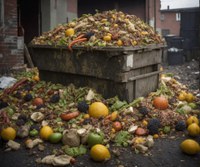Prairie Fare: How to get a handle on food waste
(Click an image below to view a high-resolution image that can be downloaded)
I always feel bad when I throw away food, even when it is no longer edible.
The other day I was getting a beverage out of the small refrigerator in our family room. I saw a takeout container in the back.
What was a takeout box doing in this fridge? Sometimes our kids put food in this fridge. They had not visited in a while, I thought to myself.
I opened the white container. I almost dropped the box. I could not recognize what the food was. I probably would not be able to write this column if I had tasted the food.
Of course, the container and mysterious contents went in the trash.
Unfortunately, lots of food in the U.S. gets wasted every year. “Food waste” means that food is not eaten and is discarded. “Food loss” happens before food reaches us, and can happen during storage, processing and transportation.
Food waste can happen anywhere along the way in the food chain, including homes, grocery stores and restaurants.
Let’s try a quiz to see what you already know. These questions and answers are based on the statistics from Feeding America and other sources.
1. About what percentage of food is wasted, on average, in the U.S. annually?
- 15%
- 25%
- 40%
- 50%
2. About how many meals are wasted in the U.S., based on the pounds of food wasted?
- 40 billion
- 79 billion
- 110 billion
- 149 billion
3. True or False: Close to one half of all the food waste is from the food industry, not homes.
4. List three of the most-wasted foods in the U.S.
The answers are 1) c. 2) d. 3) True. 4) Some of the most commonly wasted foods are bread, milk, potatoes, cheese and apples.
Sometimes we toss foods that might still be edible. Dates on packages can be a little deceptive. Most product dates are not “expiration” dates; they are “best if used by” dates. That means they tell us when the food is at its best quality, including color, texture and flavor. The food is likely safe to eat beyond the date.
According to the U.S. Department of Agriculture, commercially canned vegetables, such as green beans and corn, are safe and high quality up to five years in your cupboard. Commercially canned acidic foods, such as tomatoes and fruit, are safe and high quality up to 18 months after purchase. Be sure to mark cans with the date of purchase and arrange your cupboards in a first-in, first-out order.
What are some of the reasons people toss foods prepared at home? Like many people, I eat leftovers every day for lunch, but some people do not like leftovers. In that case, the food is tossed after dinner time. Consider reducing the number of servings you make. Find recipes that fit your household size. Some recipe sites allow you to indicate the number of servings you need.
If you do not use all the ingredients to make a particular dish, freeze the remaining ingredients in freezer bags or freezer containers. Consider freezing bread, cheese and even milk. Be sure to label the bag or container with the date. See the “Food Freezing Guide” from NDSU Extension.
Use the leftover foods in new ways. Some leftover ingredients, such as celery leaves and other vegetable trimmings, can be used to make homemade vegetable stock for soups and stews.
Consider composting leftover food such as vegetable peelings. Do not compost meat scraps, though. Search online for “How to Compost” from NDSU Extension. It explains how to make “black gold” from your vegetable waste in your kitchen and yard waste. This rich organic material can help plants grow.
If you have a successful garden, share your bounty with others, including food pantries, and preserve food through freezing, canning, drying or fermenting.
Bread is a commonly wasted food, here’s a way to use stale (not moldy) bread. You might also try making croutons, bread pudding or a breakfast casserole.
French Toast
8 slices whole-wheat or white bread (about ½ inch thick), preferably day-old or stale
4 eggs (beaten)
½ cup fat-free or low-fat milk
½ teaspoon canola oil (or other oil)
2 tablespoons maple syrup (optional)
½ teaspoon vanilla extract
1 teaspoon ground cinnamon
Dash of salt
Toppings of choice (fruit, syrup, peanut butter, etc.)
Preheat a griddle or nonstick skillet on the stove over medium heat. Whisk together eggs, milk and maple syrup, if desired. Add vanilla, cinnamon and salt and stir until thoroughly combined. Dip both sides of the sliced bread into the egg mixture and place on griddle or skillet. Fry the bread on one side for about two minutes, or until it browns, then flip it to fry the other side. Serve with desired toppings.
Makes eight servings. Each serving has 140 calories, 3.5 g fat, 8 g protein, 19 g carbohydrate, 4 g fiber and 210 mg sodium.
(Julie Garden-Robinson, Ph.D., R.D., L.R.D., is a North Dakota State University Extension food and nutrition specialist and professor in the Department of Health, Nutrition and Exercise Sciences.)
NDSU Agriculture Communication – March 28, 2024
Source: Julie Garden-Robinson, 701-231-7187, julie.garden-robinson@ndsu.edu
Editor: Elizabeth Cronin, 701-231-7006, elizabeth.cronin@ndsu.edu




